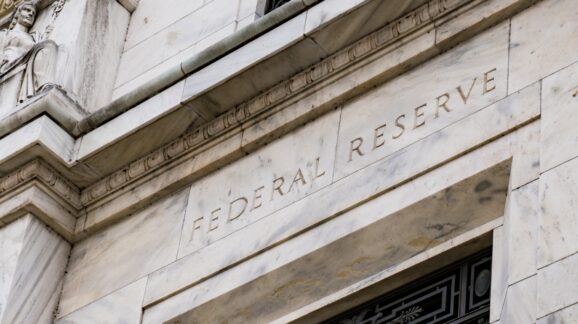Fed Hikes Interest Rate: Bigger News on Bond Portfolio Mostly Neglected

Photo Credit: Getty
The Fed this week announced a half percentage point hike in its federal funds rate. This is the right thing to do, but it will have only a small effect on inflation. Far more important is an announcement the Fed made the same day, but got far less coverage. It will finally begin winding down its balance sheet of government bonds in June. Buying and selling bonds is the Fed’s single most powerful inflation-adjustment tool, far more powerful than interest rate adjustments. It should have started selling off bonds months ago, but June is better than never.
Inflation (or deflation) happens when there is a mismatch between the money supply and real economic output. If one grows or shrinks, the other needs to grow or shrink by a matching amount, or there will be inflation or deflation. The Fed’s job is basically to play a matching game.
Buying bonds is how the Fed directly increases the money supply—which directly increases the inflation rate. When the Fed buys bonds, it pays for them with money that it newly creates. This new money then winds its way through the economy.
If the Fed wants to directly shrink the money supply—and directly reduce the inflation rate—it can sell bonds. The money it makes from the sales can then be retired from circulation. Interest rate adjustments, by comparison, have only indirect effects on the amount of money in circulation.
In ordinary times, the Fed should engage in some bond buying. If real economic output goes up by 3 percent, the money supply should go up by a matching amount to prevent deflation. Since the Fed has a 2 percent target inflation rate, the Fed would instead usually react to 3 percent growth, with a 5 percent money increase—3 percentage points to match real growth plus two extra percentage points to meet the Fed’s inflation target. (The Fed’s exact response should vary depending on other factors, but this simplified illustration tells the essential story.)
That is not what happened during the pandemic. The Fed’s bond holdings grew by 72 percent in three months, then grew some more. It was the largest bond-buying spree in the Fed’s history. The Fed’s bond holdings totaled about $4.1 trillion when COVID-19 hit in February 2020. Three months later, it was $7.1 trillion. It continued buying bonds until March 2022, and its portfolio now stands at $8.9 trillion.
The Fed’s announced selloff is modest in this context, and may not be enough to substantially reduce inflation when the lag time ends sometime next year. It will reduce its $8.9 trillion portfolio by $47.5 billion per month for three months, then $95 billion per month for an unspecified amount of time.
Winding down inflation comes with a risk of recession, which explains the Fed’s timidity, especially in light of last quarter’s GDP contraction. So, the Fed has its reasons, though they are not entirely convincing, considering the short-term and long-term pain that inflation causes.
Nor did the Fed’s initial buying spree come out of nowhere. When people stop spending money, the Fed’s typical response is to inject some new money into the economy as a form of stimulus. It can work in the short run, though usually with the tradeoff of some slowdown later on.
The trouble is that the Fed misread the situation during the pandemic. It wasn’t a typical recession. There was no financial crisis, housing bubble, or economic malady. A healthy economy shut down for a bit, then opened back up. The virus had to pass so people could safely open back up, and that’s it. The Fed used the traditional tools to fight a new battle, and that is the biggest driver of today’s inflation. Overspending by the political branches didn’t help, but that explains only about 1 percentage point of 8.5 percent inflation.
There is a lag time in bond-buying actions from about six 6 to 18 months, since it takes time for new money to move from bond sellers’ wallets out to the larger economy. The rise in inflation that began in 2021 was the result of the Fed’s 2020 bond-buying spree. Since the Fed isn’t trimming its bond portfolio until June 2022, even if inflation has already peaked, it will likely remain high at least until early 2023 and possibly longer, since the Fed’s more recent buyups haven’t yet worked through the economy, and the selloffs to counter them are both late and relatively small. Relief would come sooner had the Fed acted sooner and more boldly.
Despite last quarter’s GDP decline, economic output is already back to where it would have been if COVID had never happened. Because of today’s needless inflation, the Fed’s delayed response in fixing it, plus overspending and general policy bungling by Congress and two presidents, a recession that COVID couldn’t cause might happen anyway. While this week’s interest rate hike will get all the attention, the real news is the Fed’s coming bond selloff.
A subsequent post will explain why the federal funds rate has only a small effect on inflation, and why journalists and stock markets should pay less attention to it.